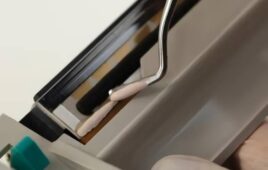Wearable glucose monitors have changed the lives of many people living with diabetes. These monitors must stick to the skin, but not too much. Learn how the science behind sticking to skin affects a device’s success and how to mitigate three diabetic device design challenges with adhesives.

[Image courtesy of 3M]
An adhesive is a critical component in ensuring diabetes devices’ accuracy and reliability. It not only helps extend diabetic device wear time but keeps users safe from device-associated skin injuries.
To help mitigate potential issues and enable diabetic device innovation, it’s important to understand how to overcome common diabetic device design issues, as well as the science behind sticking to skin.
Sticking to Skin
Skin is a highly complex organ that needs to breathe, move and expel moisture. When improperly designed, wearable devices inhibit all three of these functions. To set your device up for success, consider the following characteristics that affect skin:
- Age. Aging takes a toll on skin, and every stage of life comes with its own characteristics. For instance, infants and the elderly have thin, fragile skin that’s easily damaged, whereas healthy young adults have more durable, elastic skin. Knowing the intended user for your device is critical to understanding the level of adhesion their skin can withstand.
- Moisture. Because skin is largely made up of water, both the device and adhesive must allow moisture to escape. When moisture gets trapped, it can cause maceration (a medical-adhesive related skin injury, MARSI, that results from essentially drowning the skin) and can cause the device to fail.
- Hair growth. While not a consideration for all areas of the body, hair growth can cause the device to fall off by pushing up against it.
- Lifestyle. Know how active your intended user will be and where (geographically) the device will be used. If the user lives in a humid climate and has an active outdoor lifestyle, their sweat levels may be higher than those of someone living in a cold, dry climate.
How to mitigate three common diabetic device design issues
Adhesives, though a seemingly small component, can make or break a device’s functionality. Here are three diabetic device design issues related to adhesives you need to be aware of, as well as advice on how to mitigate them:
-
- Device prematurely detaches from skin. To keep this from happening, consider a pressure-sensitive medical adhesive with a breathable backing. Some adhesives can adhere for up to two weeks, and a breathable backing will help the skin function as normally as possible. Also, using an adhesive skirt that extends beyond the device can reduce lift from everyday wear.
- Wearer experiences skin irritation. When designing devices that will adhere to skin, remember that “tape is tape” is a major oversimplification. Incomplete finishing or curing of an adhesive can leave a high concentration of residual contaminants that migrate into or onto the skin, leading to potential skin irritation.
- Adhesive strength is too high. The strongest adhesive isn’t always the best adhesive.
If too strong of an adhesive is used, the bond between adhesive and skin can be stronger than skin-to-skin, causing the skin to strip away from the body upon removal. Consider the device’s or sensor’s intended wear time and select an adhesive that matches up. Over-designing will only lead to additional problems – not to mention pain to the user.
Managing diabetes can feel endless, but a well-designed device can make living with the disease less cumbersome. Carefully considering your adhesive options to choose the right stick-to-skin adhesive may make life a bit simpler for people living with diabetes. Partnering with a knowledgeable expert can also help mitigate these and other unforeseen issues.
Del Lawson has more than 25 years of experience at 3M in laboratory management, strategic product platform creation and Lean Six Sigma operations. His experience has involved new technology creation in advanced analytics and sensors, biotechnology solutions and medical adhesives. Lawson leads new product development and commercialization efforts in 3M’s Medical Solutions Division.
The opinions expressed in this blog post are the author’s only and do not necessarily reflect those of Medical Design and Outsourcing or its employees.




